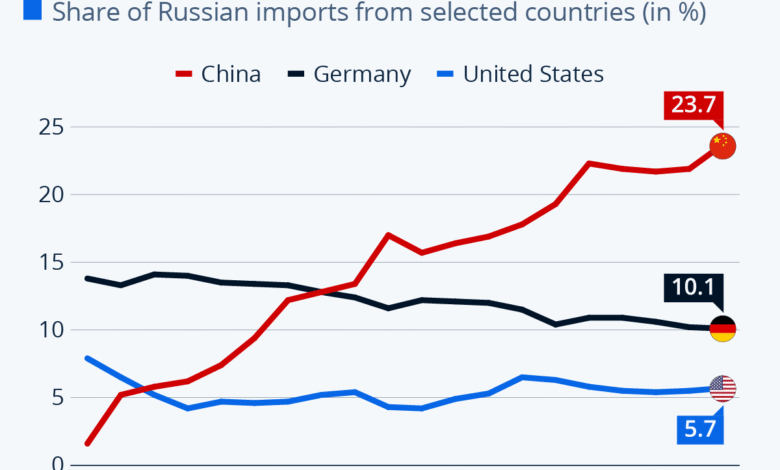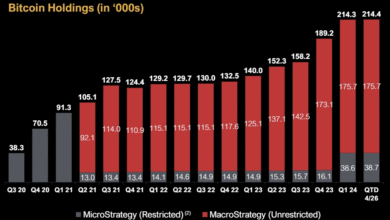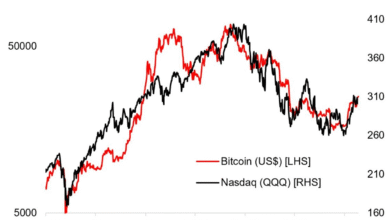China Russia Trade Reaches Record High Amid Tariff Threats

China-Russia trade has reached remarkable heights, especially in the current geopolitical landscape, where both nations have solidified their economic partnership. Recent statistics from the Chinese General Administration of Customs reveal that trade volumes surged to an impressive $19.14 billion in July, fueled largely by Chinese exports to Russia and significant Russia oil exports to China. A notable portion of this dynamic exchange involves oil imports from Russia, positioning China as a key player in the global energy market, particularly in crude oil imports. This bilateral trade agreement showcases China’s reliance on Russian energy supplies, despite the backdrop of looming tariffs and sanctions. As a result, the relationship between these two countries continues to evolve, presenting lucrative opportunities for both economies amidst a shifting international trade framework.
In recent years, the economic synergy between the two vast nations of China and Russia has become increasingly prominent. The mutual trade relationship has evolved into a robust alliance, particularly in sectors like energy and commodities. With China as a leading importer of Russian oil, it’s essential to consider the implications of the bilateral negotiations that govern their exchanges. The ongoing dynamics of Chinese-Russian commerce highlight an intricate web of dependencies and strategic partnerships, especially concerning oil and related goods. As these countries navigate a complex geopolitical landscape, their continued collaboration is poised to shape regional and global economic trends.
China and Russia Trade Dynamics: An Overview
The trade relationship between China and Russia has intensified significantly over the past few years, especially in light of geopolitical shifts. With historical ties and strategic interests aligning, bilateral trade reached a peak of $19.14 billion in July, according to the latest reports from the Chinese General Administration of Customs. This figure not only reflects a sharp increase of 8.7% from the previous month but underscores the resilience of these two economies amidst external pressures, such as tariffs imposed by Western countries.
While the ongoing Ukraine-Russia conflict poses challenges, it also acts as a catalyst for deeper integration between the two nations. The reported figures indicate that Chinese exports to Russia are becoming vital to the health of the Russian economy, especially in sectors that might be feeling the pinch of international sanctions. Consequently, the dynamics of trade between these two countries are an important area of focus for economists and policymakers alike.
Frequently Asked Questions
What is the current status of China Russia trade in 2025?
As of 2025, China Russia trade remains robust, with trade reaching a significant peak during July, totaling $19.14 billion. Russian crude oil continues to be a major component of this trade, with 49.11 million metric tons delivered to China despite sanctions and challenges in Russian oil exports.
How do Chinese exports to Russia impact the bilateral trade agreement between the two countries?
Chinese exports to Russia play a crucial role in the evolving bilateral trade agreement, which has strengthened since the Ukraine-Russia conflict. The increasing volume of goods and services exchanged, supported by strategic partnerships, highlights the growing economic ties between the two nations.
What percentage of China’s crude oil imports comes from Russia and how has it changed recently?
In 2024, Russia accounted for 19.6% of China’s crude oil imports, with exports totaling 108.5 million metric tons. However, there has been a slight decline of 10.9% in imports from January to June, as China adjusts to geopolitical dynamics affecting oil imports from Russia.
Are there any tariffs affecting Russian oil exports to China?
Despite the looming threat of secondary tariffs on Russian oil exports to China, trade volumes have not significantly decreased. China remains committed to sourcing Russian crude oil, indicating resilience against U.S. government pressures regarding trade policies.
How do ongoing geopolitical tensions affect China Russia trade?
Ongoing geopolitical tensions, particularly related to the Ukraine conflict, have influenced China Russia trade; however, partnerships remain strong. China continues to be one of the largest buyers of Russian crude oil, signaling a willingness to navigate challenges presented by international sanctions.
What are the implications of potential U.S. tariffs on Chinese imports for China Russia trade?
Potential U.S. tariffs on Chinese imports could complicate China Russia trade dynamics. If tariffs are implemented, it may prompt China to reinforce its import relationships with Russia, particularly concerning crude oil, to mitigate negative impacts on its economy.
How is China reacting to the potential secondary tariffs on Russian oil?
China appears to be unfazed by the potential secondary tariffs on Russian oil, as it continues to import substantial quantities of oil from Russia. This suggests a strategic outlook on trade stability and expectations for future geopolitical resolutions.
What role do sanctions play in current China Russia trade relations?
Sanctions have created challenges for Russia’s oil exports, yet they haven’t drastically affected China Russia trade. China’s significant imports of crude oil from Russia indicate that both nations are adapting to the sanctions while maintaining strong trade ties.
What future trends are expected for China Russia trade in light of current events?
Future trends for China Russia trade suggest continued growth, particularly in crude oil imports. As China navigates geopolitical tensions and potential tariff obstacles, it will likely bolster its economic ties with Russia, especially in energy sectors.
What can we expect from the China Russia trade partnership in the coming years?
In the coming years, we can expect the China Russia trade partnership to deepen, particularly in energy exports. Despite international pressures, China’s demand for Russian crude oil positions Russia as a critical supplier in China’s energy strategy.
| Aspect | Details |
|---|---|
| Peak Trade Volume | Trade peaked in July at $19.14 billion, an 8.7% increase from June. |
| Crude Oil Imports | China is a major buyer, importing 108.5 million metric tons from Russia in 2024, which made up 19.6% of its crude oil imports. |
| Impact of Sanctions | Despite sanctions and threats of tariffs, trade volumes remain substantial, indicating resilience in China-Russia trade relations. |
| Future Prospects | China may anticipate a resolution to the Ukraine conflict, impacting future trade tariffs. |
| U.S. Tariff Threats | Ongoing discussions about potential secondary tariffs from the U.S. could complicate trade relations. |
Summary
China Russia trade has shown resilience, reaching a peak in July despite geopolitical tensions. As one of the largest consumers of Russian crude oil, China’s trade with Russia is crucial for both countries. The solid trade volume highlights the strengthening partnership between these nations, even in light of potential tariffs and sanctions from the U.S. Trade between China and Russia is expected to maintain its importance moving forward, reflecting a complex interplay of international relations and economic strategies.




